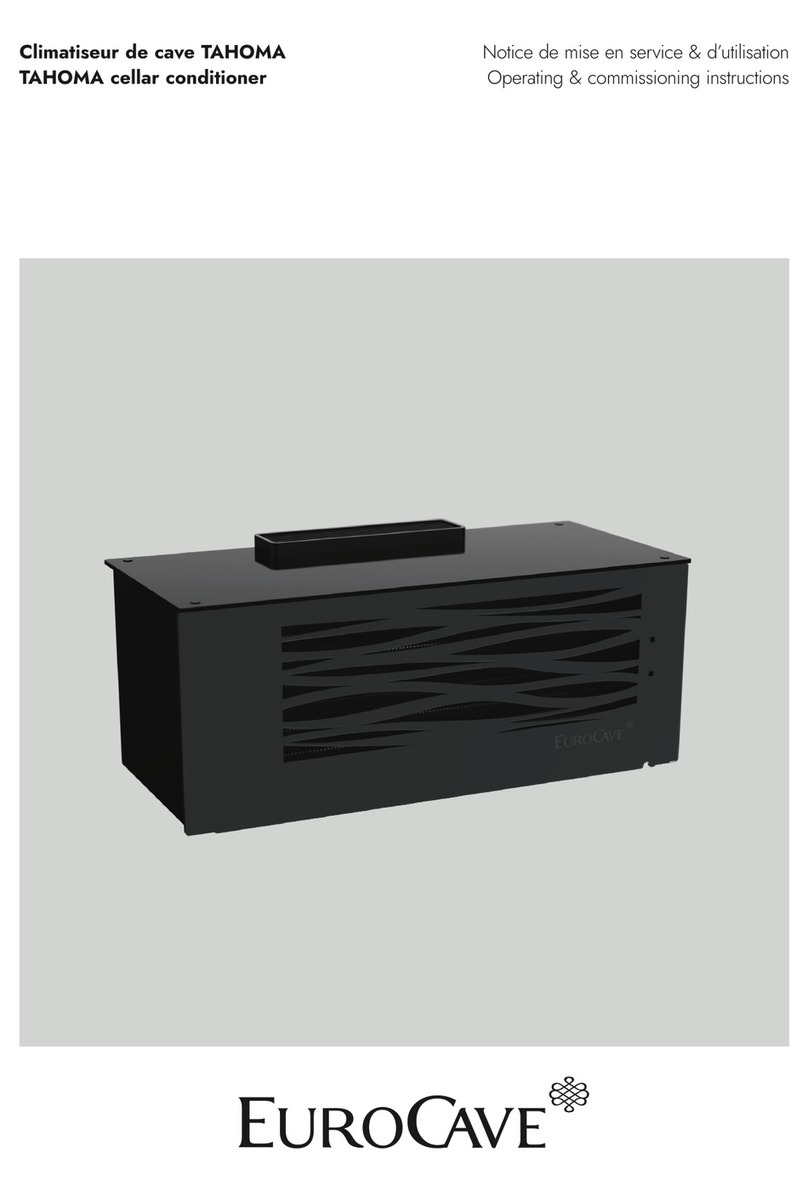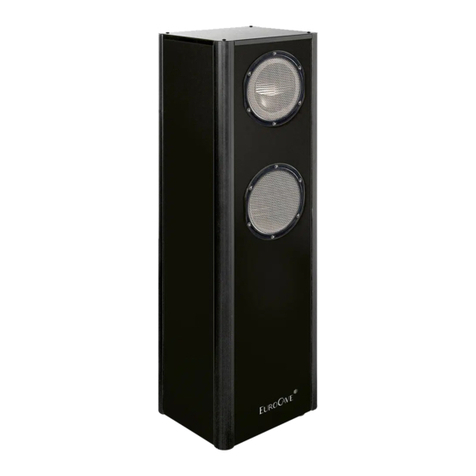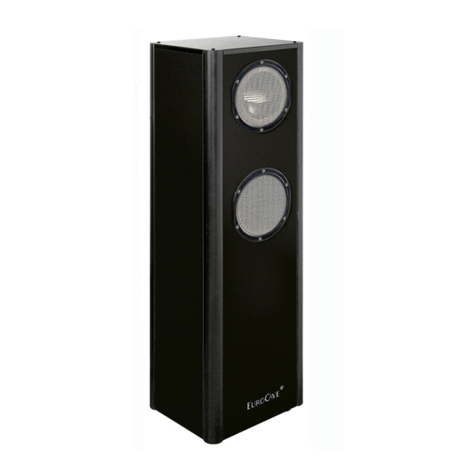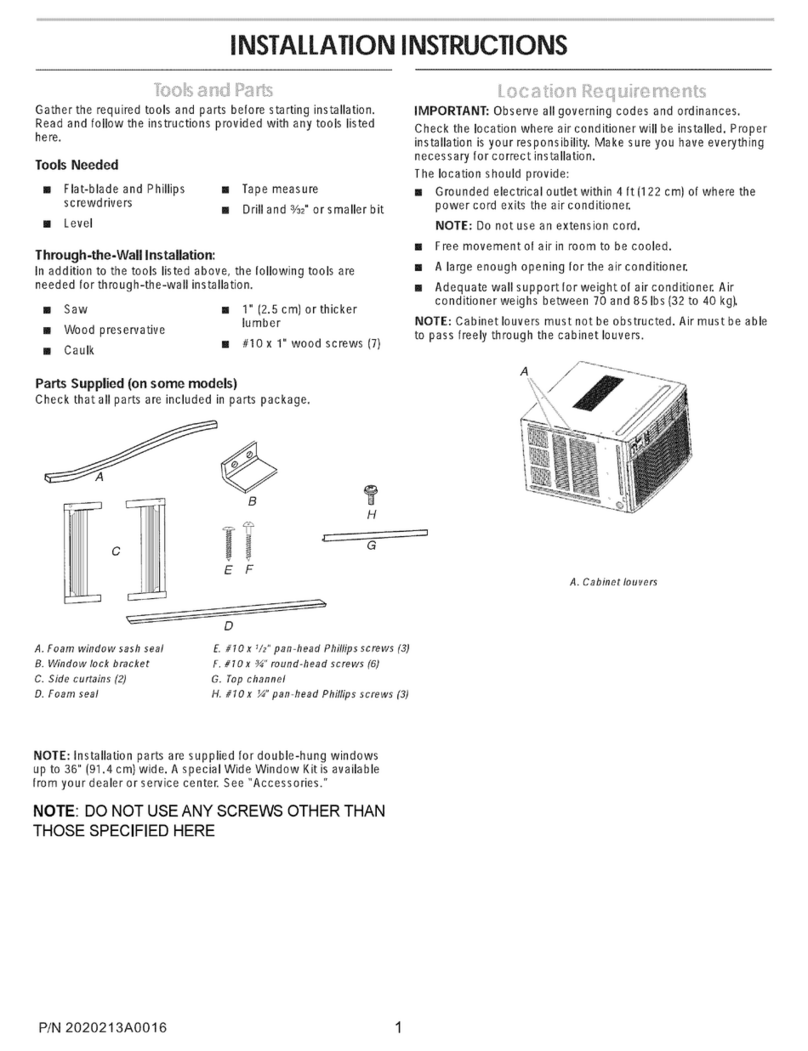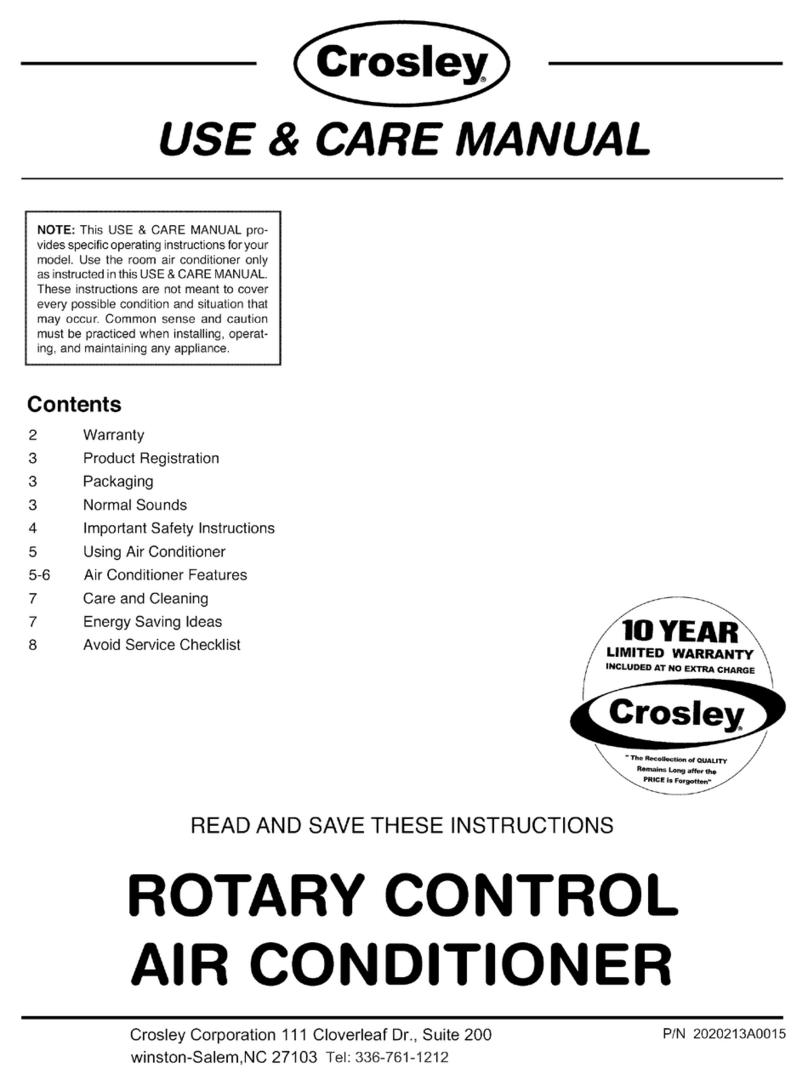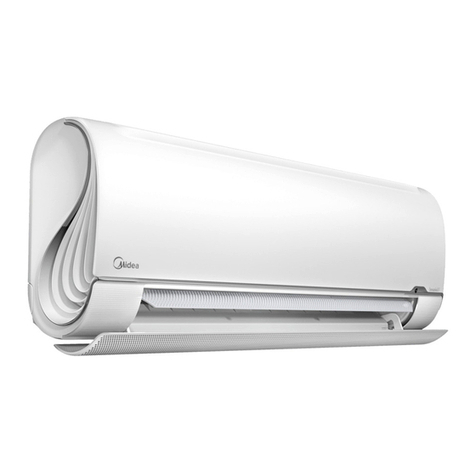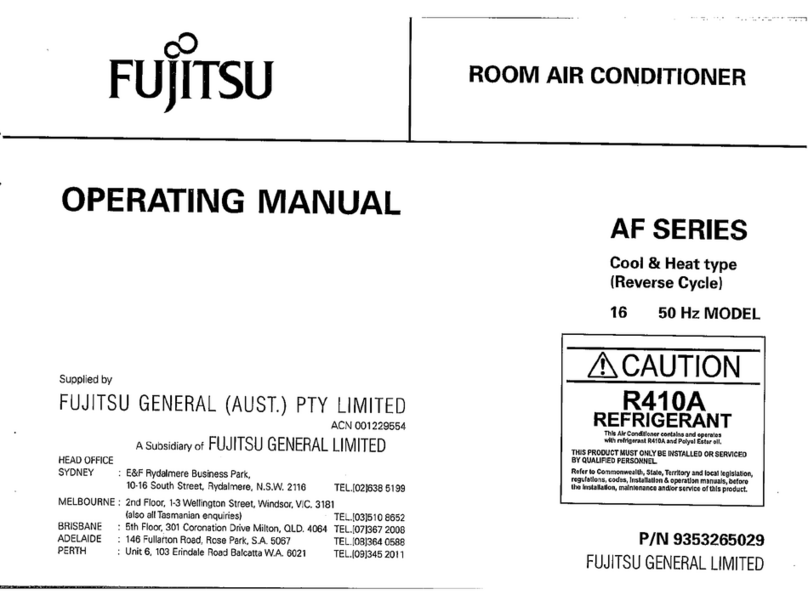Eurocave INOA25 User manual

Operating and installation instructions - INOA cellar conditioners
March 2009
1

CONTENTS
WELCOME TO THE WORLD OF EUROCAVE
1 • CONDITIONER DESCRIPTION
2 • IMPORTANT SAFETY RECOMMENDATIONS
3 • ELECTRICAL POWER SUPPLY
4 • CARE FOR THE ENVIRONMENT AND ENERGY SAVING
5 • TECHNICAL SPECIFICATIONS
6 • CELLAR INSULATION
7 • INSTALLING YOUR CONDITIONER
I- General points
II- Drilling the wall
III- Fitting
IV- Discharging condensate
8 • CONDITIONER OPERATION
9 • INSTALLING THE REMOTE CONTROL
I- Remote control description
II- Installing the remote control inside the cellar
III- Installing the remote control outside the cellar
10 • COMMISSIONING YOUR CONDITIONER
I- Connection
II- Switching on
III- Remote control description
IV- Installing the remote control
V- Setting the temperature
VI- Silent function
VII- “Heating” function
VIII- Changing the remote control batteries
IX- Discharging condensate
11 • MAINTENANCE
12 • OPERATING FAULTS
2
Venting plate and wall mounting bracket dimensions
p.18
p.15
p.15
p.15
p.16
p.18
p.18
p.18
p.19
p.19
p.20
p.20
p.20
p.20
p.21
p.21
p.7
p.8
p.9
p.9
p.10
p.10
p.11
p.13
p.14
p.6
p.6
p.4
p.5
p.6

Solutions to meet all your needs
WINE CABINETS
STO RAGE SYSTEMS
CELLAR CO N DIT IO N ERS SYSTEM TO SERVE W INES BY THE GLASS
O rigine C lassic C ompact
Leather Meuble à Vins Elite
Modulothèque Modulocube Modulorack
Inoa* Vin auVerre*
Sommelier
* Product not available in certain countries.
3

O ur greatest wish is to accompany your enthusiasm for wine throughout the years…
To do so, EuroC ave puts all of its know-how into action to bring together the essential factors in optimal wine maturing:
Temperature:
The two worst enemies of your wine are extreme temperatures and sudden uctuations in temperature.
A constant temperature of 10° to 14°C (50 to 57°F) is considered to be ideal for your wine to reach its full potential.
O wing to its electronic regulation system, your EuroC ave INOA conditioner is activated as soon as the cellar
temperature rises one degree above the programmed temperature. Furthermore, the presence of a heater built into the
air distributor protects your wine from any signicant fall in temperature.
Humidity:
This is an essential factor, enabling corks to retain their sealing qualities. The level of humidity must be higher than 50%
(ideally between 60 and 75 %).
By maintaininga constant evaporation temperature, above 0°C , your EuroC ave INOA conditioner ensures minimal drying
out of the air of your cellar and an ideal level of humidity.
Protection from light:
Light, and more especially its ultra-violet component, will rapidly prove noxious to your wine by irreversible oxidation of
its tannins. For this reason we strongly advise that wines be stored in the dark, far from U.V. light.
Protection from vibration:
Vibration disturbs the slow process of your wine’s biochemical evolution, and is often fatal for the nest wines.
The housing of your EuroC ave conditioner is fully sound-proofed (by 20 mm polyethylene foam) and the compressor and
fans are tted with silent blocks to absorb any residual vibration.
Natural aeration:
A constant supply of air from the outside is also indispensable.
All of these specic features can be found in the EuroC ave IN OA conditioner you have bought. We thank you for the
condence you have placed in us.
French wines
Alsace 10°C
Beaujolais 13°C
Bordeaux Sweet W hite 6°C
Bordeaux Dry W hite 8°C
Bordeaux Red 17°C
Bourgogne W hite 11°C
Burgundy Red 18°C
Champagne 6°C
Jura 10°C
Languedoc-Roussillon 13°C
Provence Rosé 12°C
Savoie 9°C
Vins de Loire Dry W hite 10°C
Vins de Loire Sweet 7°C
Vins de Loire Red 14°C
Vins du Rhône 15°C
Vins du Sud O uest Sweet 7°C
Vins du Sud O uest Red 15°C
Australian wines
Cabernet franc16°C
Cabernet sauvignon 17°C
Chardonnay 10°C
Merlot 17°C
Muscat à petit grain 6°C
Pinot noir 15°C
Sauvignon W hite 8°C
Semillon 8°C
Shiraz 18°C
Verdhelo 7°C
Other wines
C°61ainrofilaC
C°51elihC
C°71niapS
C°61ylatI
Usual wine serving temperatures
WELCOME TO THE WORLD OF EUROCAVE
4

1 - Conditioner / ceiling distance: 200 mm min.
2 - Ceiling
3 - Cellar wall
4 - Metal mounting frame
5 - Flexible ducting
6 - Aesthetic front panel
7 - Grid, to be cleaned regularly (see p.11)
8 - Mounting frame / conditioner seal
9 - Evaporator, to be cleaned regularly
10 - Condenser, to be cleaned regularly
11 - Inside of cellar
12 - Remote control
13 - Grid securing screws (quantity:24)
14 - Aesthetic front panel securing screws
(quantity: 4)
15 - Screws to x frame to the wall (quantity: 4)
16 - Screws to x conditioner to the frame
(quantity: 4)
1 - CONDITIONER DESCRIPTION
HOT AIR
COLD AIR
5

2 - IMPORTANT SAFETY RECOMMENDATIONS
Your conditioner’s power lead is supplied without a plug. Installation of a power plug or connection of the conditioner to a junction box must be carried
out by a qualied electrician.
In all cases, the connection of your conditioner must be carried out on an earthed socket to prevent any risk of electric shock.
Have an electrician carry out the installation. He will tell you whether or not the socket is correctly earthed and, if necessary, will perform any work required
to bring your installation in line with standards.
IMPORTANT: any electrical work must be carried out by a qualied electrician.
Electric connection must be carried out by means of a device to ensure isolation from the mains system.The isolating device should open all of the contacts
of all the poles ensuring complete disconnection in line with the conditions in over-voltage category III. Installation must be carried out in compliance with
national installation regulations.
Should you move to another country, check that the conditioner’s electrical rating (see grey identication label) complies with the country (voltage,
frequency).
Ensure that the plug (230 V – 13 A*) is correctly earthed and that your installation
is protected by a dierential circuit breaker (30 mA*).
*not valid for some countries
3 - ELECTRICAL POWER SUPPLY
For your personal safety, the conditioner must be correctly earthed.
4 - CARE FOR THE ENVIRONMENT
AND ENERGY SAVING
Never use your conditioner for anything other than its specic purpose as described in this guide.
Never unplug the conditioner by pulling on the supply lead.Take a rm hold on the plug and pull out smoothly in a
straight line from the wall socket.
If the power lead is damaged, it must be replaced by a qualied electrician.
Do not allow children to climb, sit, stand on or hang from the conditioner.They could damage the conditioner, as well
as badly hurting themselves.
Never damage your appliance’s refrigeration unit.
W hen using your conditioner, you
should always observe certain
basic precautions, especially:
Warning
Disposal of packaging:
The packaging used by EuroC ave is made of recyclable materials.
After unpacking your conditioner, take the packaging to a waste disposal centre. For the most part it will be recycled.
Recycling:A caring gesture
Electrical and electronic equipment have potentially hazardous eects on the environment and public health due to the presence of
noxious substances.
You should therefore never dispose of electrical or electronic equipment with unsorted municipal waste.
W hen buying a new EuroC ave product (wine cabinet, cellar conditioner,Vin au Verre), you can take advice about the recycling of your old appliance from
your EuroC ave dealer.
In compliance with legal provisions covering respect and care for the environment, your conditioner does not contain C FCs.
Energy saving:
- Install your conditioner in an appropriate place and within the recommended temperature ranges.
- Keep the door open for as short a time as possible.
N.B.: C are for the environment: when replacing your conditioner, consult your local municipal refuse department in order to observe the appropriate
recycling procedure.
For refrigerant gases, substances and some parts contained in the conditioner, EuroC ave uses recyclable materials which require a special packaging disposal
procedure to be followed.
Place unusable appliances out of use by unplugging them.
6

INOA CELLAR CONDITIONER
EuroCave Inoa 25 Cellar conditioner
Dimension W385 x D322 x H1250 mm
Weight: 43 KG
Power supply 230V / 50 Hz
Volume up to 25 m3 (*)
Cooling Capacity 600W
Electrical Power 500W (**)
Heater element 650W
Cooling Gas: R134a
External Temp -5°C to 35°C
Noise level: 44dbA – 50dbA
Supplied with a 3.50 m power lead without plug
Ref: INOA 25
EuroCave Inoa 50 Cellar conditioner
Dimension W385 x D322 x H1250 mm
Weight: 46 KG
Power supply 230V / 50 Hz
Volume up to 50 m3 (*)
Cooling Capacity 1200W
Electrical Power 800W (**)
Heater element 650W
Cooling Gas: R134a
External Temp -5°C to 35°C
Noise level: 44dbA – 50dbA
Supplied with a 3.50 m power lead without plug
Ref: INOA 50
INOA 25 INOA 50
SP ECI F ICATIONS
*for an isolated wine cellar following our advice please refer to our insulation guide
** for an internal temperature of 12°C and an external temperature of 32°C
FUNCTION
The purpose of the cellar conditioner is to climate control any kind of fully
insulated room creating an ideal wine cellar environment by monitoring and
adjusting the temperature and humidity.
TEC HNOLO GY
The conditioner’s housing is dampened against sound and the compressor
and fans are fitted with silent blocks to absorb any residual vibration.
A quiet conditioner: the system automatically adjusts speeds to ambient
temperature conditions, combined with the use of particularly quiet fans,
allows the conditioner to operate very discreetly.
Energy efficiency: Inoa conditioners use the compressor infrequently,
insulation between the condenser and the evaporator minimises any
exchange between the cold and hot sections of the appliance, thus favouring
energy efficiency.
The Inoa come as standard with the hot air discharge opposite the cold air
exit. It can be ordered with the hot air exit on the left or the right side as an
option.
Important information
For insulation, installing, positioning and more please make sure you have read our Installation
guide and our Insulation guide.
5 -T ECHNICAL SPECIFICATIONS
7

2 - TECHNICAL SPECIFICATIONS
3 - CELLAR INSULATION
Dimensions Power Sample Cooling Weight Electrical Heating RefrigerantExternal
in mm supply volume m
3
serutarepmetWecnatsiserWrewopgKWyticapac
Inoa 25 W385 x D322230V up to 600W**43 Kg 550W**650W R134a-5°C to 35°C
x H1250 / 50 Hz 25 m
3
*(without CFCs)
Inoa 50 W385 x D322230V up to 1200W**46 Kg 800W**650W R134a-5°C to 35°C
x H1250 / 50 Hz 50 m
3
*(without CFCs)
* in a very well insulated room - ** for an internal temperature of 12° C and an external temperature of 32° C.
Supplied with a 3.50 m power lead without plug.
Traditional building materials such as stone, concrete and brick are very poor insulators and only underground sections represent any real insulation.
It is therefore essential, in the majority of cases, to insulate the entire room to be conditioned.
Insulate – yes but how?
We recommend that you use extruded polystyrene, currently the most ecient product on the market. It is the least ammable andthe most durable
material. It also has the advantage of not being attacked by rodents. Furthermore, extruded polystyrene boards can be layered andtherefore prevent thermal
bridges.To increase your conditioner’s lifespan and reduce electricity consumption, we recommend that you use extruded polystyrene which is at least 80
mm thick.
80 mm of extruded polystyrene provides the same amount of insulation as a 5m thick stone wall.
The insulation must be completely continuous (no gaps).
Insulation boards: dierent methods of tting are possible
How can you determine whether or not a material is a good insulator? The insulation performance of a material is established by its R thermal resistance
(m2.°C/W). It determines the material’s ability to conduct heat.
R = e/λ- The greater the R coecient, the better the insulation. (λ= thermal conductivity coecient)
There are 3 types of insulation boards:
Insulator only, complex (with plaster cover) or sandwich (plaster both sides)
Depending on the type of insulator chosen, several methods of tting are possible:
•Against the walls
- Standard extruded polystyrene board: pre-cut to the dimensions of the area to be conditioned, they are tted using high-bond mortar. For a more acceptable
nish, it is possible to x rails onto which you screw the plaster board panels over the polystyrene.
- Sandwich or complex boards: the polystyrene is already integrated into the plaster board.
Whatever the method used, all kinds of decorative nishes are possible to obtain an attractive wall.
If you only want to condition a section of your room, install a plaster board dividing wall then insulate the side of the room to be conditioned.
N.B.: Before being insulated, walls must be clean. If they are too damp, clean them with a wire brush then clean with a high pressure water jet and paint with
an emulsion paint.
•On the ceiling and door
The process for insulating the ceiling and door is identical to that of the walls.We recommend that you use extruded polystyrene.
•On the floor (insulation optional)
- Original clay oor: not insulating favours the passage of humidity, which is good for the wine.
- Concrete oor (for example): Concrete is a very poor insulator. A few centimetres of ne gravel can, in some cases, improve insulation.
It is essential that the surface material used for the oor (whether or not covering
insulation) can support the weight of wine racks and has resistance to compression.
Tools required
- handsaw, tape measure, bricklayer’s ruler, trestles, screwdriver or screw gun, drill, hammer, level, plumb line, wood mallet, spatula, precision knife...
8

4
GB
7 - INSTALLING THE CONDITIONER
I - General points
- Never damage the appliance’s refrigerating circuit.
Your conditioner’s power lead is supplied without a plug. “Fitting a power plug or connecting the conditioner to a junction box must be carried out by a
In all cases, connection of your conditioner must be carried out on an earthed socket to prevent any risk of electric shock.
*not valid for some countries
IMPORTANT : any electrical work must be carried out by a electrician. Power outlet not valid for some countries.
Electric connection must be carried out by means of a device to ensure isolation from the mains system. The
isolating device should open all of the contacts of all the poles ensuring complete disconnection in line with
the conditions rin over-voltage category III. Installation must be ca ried out in compliance with national
installation regulations.
•Positioning your conditioner:
The conditioner produces cold air inside the cellar and expels hot air outside (see diagramA).
- Do not install the conditioner facing the door of the room (risk of condensation on the door joints).
- Do not place the external section of the conditioner above a source of heat.
- For insulation reasons, there must be no windows or bay windows in the room to be conditioned.
- Is it not better to state that pipes with hot water must be insulated so that there is no heat loss?
-The exterior of the conditioner must not be located in an area subject to ingress of rain, wind, snow or poor
quality air.
- No heat-producing appliance must be located in the area to be conditioned (e.g. refrigerator, radiator, boiler).
- Do not obstruct the air entry and exit points.
- Never place a container or object containing liquid on top of the conditioner.
-The room where the hot air is expelled must, ideally, be approximately twice as large as the wine cellar and well
ventilated so that the hot air can be properly expelled.
- Wait 48 h
- Never connect several conditioners to a multi-socket.
•Recommendations:
- Fit your conditioner as close as possible to the ceiling in order to ensure uniform dispersal of cold air in the
cellar.
-We recommend that you leave a space of 200 mm between the ceiling and conditioner housing to make it easier
- Air outlets (hot and cold) must not be obstructed by any obstacles (minimum distance: 1500 mm).
Direct the cold air outlet so it is facing the bottles (see diagram D).
•Installation: (see B diagrams)
The conditioner was designed to be completely modular and adapt to any type of cellar.
however, installing it at a height for improved air convection).
You also have the option of expelling hot air outside the room by way of extractor piping (standard piping, 160 mm in diameter, not supplied).
Ventilated
room
Temperature:
Max.: 35°C
Min.: -5°C
CELLAR
Diagram A
Bottles
Door
Door
Conditioner
Conditioner
CELLAR
CELLAR
Diagram D
Hot air
expelled
Cold air
discharged
Cold air
discharged
Conditioner housed inside the cellar
with extraction facing forwards /
aesthetic front panel on the outside
Conditioner housed outside the cellar
with extraction facing forwards /
aesthetic front panel on the inside
Conditioner housed outside the cellar
with extraction on the left side /
aesthetic front panel on the inside.
Conditioner housed inside the cellar,
Diagram B Diagram B
Diagram B Diagram B
Bottles
Door Conditioner
CELLAR
Bottles
Hot air
expelled
9

7 - INSTALLING THE CONDITIONER
•Fitting: (see C diagrams)
The conditioner comes supplied with a metallic mounting frame which
simplies the process of drilling air entry and exit holes.
It also has extendable ducting to be cut to length (75 cm each) in order to
install the conditioner whatever the thickness of the wall.
Finally, the conditioner is supplied with an aesthetic front panel and 4 grids
for an aesthetic appearance.
II- Drilling the wall
- Determine the location of the conditioner housing (inside or outside the cellar)
- Position the metallic mounting frame:(1)
•in relation to the ceiling if tting the conditioner at a height (maintain a distance of 200
mm between the top of the frame and the ceiling),
•in relation to the oor for a low tting (maintain a distance of 80 mm between the
bottom of the frame and the oor).
- Use the metallic frame to outline the position of the 2 drill holes (2).
- Drill the wall.The holes must be larger than the outline drawn – between 210 mm min. and
280 mm max.
III- Fitting
- Fold the ring’s 4 supports inwards (1).
- Fit the 2 extendable ducts onto the rings of the metallic frame(2).
- Screw the securing rings onto the ducts(3).
- Position the metallic frame while passing the exible ducts through the 2 holes drilled into the wall(4).
- Push back the 4 supports towards the outside of the ring(5).
- Screw the metallic frame onto the wall with 2 high screws and two low screws (not supplied).Use screws suitable for the wallmaterial (6).
-We recommend that you put a bead of silicone between the plate and the wall to ensure eective sealing.
- Pull the 2 ducts (xed to the metallic frame) through the other side of the wall(7).
- Stretch the ducts to the maximum in order to make them as smooth as possible(8).
- Cut the ducts ush with the wall using a Stanley knife for the material(9) and pliers for the metallic wiring(10).
(1)
(1) (2) (3) (4) (5)
(2)
(6) (7) (8) (9) (10)
Metallic
mounting
frame
Extendable
ducting
Wall drill
holes
Aesthetic
front panel
Aesthetic
front panel
Grid
Grid
Wall drill
holes
Extendable
ducting
Metallic
mounting
frame
CmargaiDCmargaiD
Conditioner housed inside the cellar
Conditioner housed outside the cellar
10

Wall mounting bracket dimensions
Cold side
Inoa located outside the cellar
Hot side
Inoa located inside the cellar

AFTER SALES DEPARTMENT
TECHNICAL NOTE N° 031
Date : 15/11/10 Revision : 0 Page : 1 of 2
Subject: INOA-TECHNICAL DATAS AND TUBING
UNITS AFFECTED: INOA25 et INOA50
SERIAL NUMBER: All
DATE OF PRODUCTION: Since June 2007
Position of the panels :
Maximum pipe lengths recommended:
Two parts, 7 linear meters of pipe diameter 160 mm without elbow.
Or
Two parts, 5 linear meters of pipe diameter 160 mm with 3 90°‛s elbows.
Cold air outlet front side
Warm air side Cold air side
Cellar air in
Cold air out
You can only duct the warm air side.
Do not duct cold air.

AFTER SALES DEPARTMENT
TECHNICAL NOTE N° 031
Date : 15/11/10 Revision : 0 Page : 1 of 2
Subject: INOA-TECHNICAL DATAS AND TUBING
Extraction kit: AEVACLM or PEVACLM (not supplied with the air conditioner, option
to be ordered), one kit per hole.
Technical datas: INOA 230 V 50 Hz INOA25 INOA50
Maximum volume of the wine cellar 25 m3 50 m3
Cooling power 600 W 1200 W
Maximum distance for the remote control 10 m 10 m
Quantity of speeds for the condenser fan 4 4
Quantity of speeds of the evaporator fan 3 3
Condenser fan air flow (per speed : 1, 2, 3, 4) in m3/h 230, 335,
431, 563
273, 353,
473, 682
Evaporator fan air flow (per speed : 1, 2, 3) in m3/h 199, 285,
382
227, 352,
445
Gas load in R134a 400 grs 400 grs
Pressures BP and HP for 35°c (in bar) 2,3 ; 11,2 2,1 ; 10,5
Type of gas reducer Capillary Capillary
Condenser gas temperature 47°c 45°c

7 - INSTALLING THE CONDITIONER
- Position and t the aesthetic front panel to the wall (screws not supplied). Use screws suitable for the wall material(11).
-We recommend that you put a bead of silicone between the panel and the wall to ensure eective sealing.
- Fold the ange’s 4 supports inwards (12).
- Place the ducts onto the anges ensuring that they are well secured on the supports(13).
- Push the 4 supports towards the outside of the ange(14).
- On the side of the conditioner to be placed against the wall unscrew the 2 grids from the housing using the supplied Hex wrench and retain the screws.) (15).
- Using the screws retained in the last instruction, screw the 2 grids onto the aesthetic front panel(16).
- Unscrew the 2 screws on the top of the conditioner using a Hex wrench (supplied), on the side to be placed against the wall. Retain the two screws (17).
- Fix the conditioner housing to the metallic frame, taking care to press rmly onto the foam(18).
-Screw down the conditioner housing using 2 screws at the top (those retained earlier) and 2 screws at the bottom (supplied inthe accessories packet) (19).
•Fitting onto a door:
You can t the conditioner onto a door.
In this case, it is ESSENTIAL to check that the door is capable of supporting a weight of 46 kg and that it does not produce vibration.
The procedure for tting is the same as for the wall.
•Fitting close to the floor:
When the conditioner is tted close to the oor it is ESSENTIAL that it is xed to
the wall.
•Conditioner with air extraction via piping:
Repeat the steps described at the beginning of paragraph III.
Conditioner housed outside the cellar:
- On the conditioner housing, unscrew the 2 grids (openings that will not be placed against the wall) using a Hex wrench (supplied).
-Where the grids were located, position and screw, using a Hex wrench (supplied) the 2 anges* onto the housing(1) and (2).
- Fit together the reducer* (3).
- Position the air extraction piping (standard piping, 160 mm in diameter, not supplied).
*Consult your EuroCave distributor
(11)
(16)
)3()2()1(
(17) (18) (19)
(12) (13) (14) (15)
12

7 - INSTALLING THE CONDITIONER
Conditioner housed inside the cellar:
There are 2 methods for attaching the hot air extraction piping:
- Attaching the piping directly to the aesthetic front panel:
- Position and screw, using a Hex wrench (supplied), the two supplied anges* onto the aesthetic front panel(1).
- Fit together the reducer (2).
- Position the air extraction piping (standard piping, 160 mm in diameter, not supplied)(3).
- Attaching the piping directly to the conditioner housing (the extraction piping passes through the wall):
If using this method, you must not use the exible ducting supplied with the
conditioner.
- Fit the reducer* directly onto the mounting frame through the wall(1).
- Position the air extraction piping (standard piping, 160 mm in diameter, not supplied)(2) (3).
For this type of fitting, it is necessary to ensure sealing around the piping.
*Consult your EuroCave distributor
IV- Discharging condensate
The conditioner was designed to allow condensate to be discharged (discharge pipe located under the
conditioner’s housing) either inside the cellar, if the humidity level is too low, or outside the cellar.
Simply pass the pipes through the wall to discharge the condensate into the room next to the conditioner
housing.
Ensure that the piping is not cramped.
(1) (2) (3)
(1) (2) (3)
13

8 - CONDITIONER OPERATION
Cold air
Hot air
(heated if necessary)
Hot air
Evaporator
Condenser
Compressor
Fan
Turbine
Heater
The IN OA conditioner is tted with a refrigerating unit:
•an evaporator forces cold air inside the room,
•a condenser expels the hot air outside.
14
The evaporator fan operates continuously to ensure that air is constantly mixed and that temperatures
are as uniform as possible,in accordance with speeds automatically adjusted according to requirements.

I- Remote control description
Radio frequency remote control (433.92 Mhz)
Each remote control has a personalised code matched to the conditioner.
Power supply: 2 x 3V (CR 2430 battery, supplied)
II- Installing the remote control inside the
cellar
We recommend that you place the remote control as close as possible to the bottles.
Fit the unit close to your
bottles using the supplied
pegs and screws (see
diagram below)
NB: Do not place the remote control in the path of the conditioner’s cold air ow.
Temperature
indicator
Low battery
indicator
Knob
9 - INSTALLING THE REMOTE CONTROL
Temperature
units (according
to the country)
Conrmation and on/o key
Temperature and
setting display
Adjustment keys
On / o indicator
15

III- Installing the remote control outside the cellar
The remote control can also be placed outside the cellar.
In this case, it is essential to connect a sensor (supplied with the appliance) to the remote control before installing it.
a- Connecting the sensor to the remote control
- On the back of the remote control, push the 2 batteries downwards using a screwdriver (see diagram below).
- Remove the central knob, unscrew the screw with a small screwdriver and open the unit (see diagram below)
On the back, connect the sensor’s 2 wires (blue and red) to the circuit connector using a small at screwdriver (see diagram below).
You can connect either the blue wire or the red wire to the circuit connector.
Pass the wires through the recess on the top of the unit.
- Close the unit, ensuring that the wires pass through the recess and are not jammed
- Rescrew and replace the central knob
9 - INSTALLING THE REMOTE CONTROL
Battery CR2430
16

- Programming the remote control
Where placing the remote control outside the cellar, having connected the external sensor, it is essential to reprogramme the unit
-To turn on the remote control, press and hold down the key for about 8 seconds until the indicator goes o.
- First press and continuously hold down the key, at the same time press and continuously hold down the key for several seconds until three
lines appear.The model number is then displayed and ashes. .
- Press .
-The screen appears indicating IN (IN= internal installation). Press the key to change to OUT external mode.
-The display appears indicating OUT (OUT= external installation). Press to conrm.
-The pictogram appears. Press .
-The screen appears. Press .
-The pictogram appears. Press .
- .appears. Press .
-The pictogram appears. Press .
-The screen appears, then .
If you wish to reprogramme the remote control for an internal sensor, disconnect the wired sensor and reprogramme the remote control in internal mode
(IN) by repeating the rst two steps described in the paragraph above (see 5-III-b p.11):
The 2nd screen displays indicating OUT (OUT= external installation). Press the key to change to IN internal mode. Press to
conrm.
Then repeat the same steps, as indicated in the above paragraph (see 5-III-b).
c- Fitting
- Fit the remote control and sensor using the screws and pegs supplied (see diagram on page 9, chapter II).
- Place the sensor inside the cellar.
- Place the sensor as close as possible to the bottles
N.B.: the sensor has a range of 3 metres.
9 - INSTALLING THE REMOTE CONTROL
17

10 - COMMISSIONING YOURCONDITIONER
I- C onnection
Check that the plug is connected to a power supply (presence of correct amp fuses, functioning 30 mA* dierential circuit breaker - not applicable to certain
countries). W ait 48 hours before plugging in your conditioner.
II- Switching on
- Place the switch, located under the conditioner, in position 1.
- Press and hold down the key on your remote control for about 8 seconds, until the indicator goes o.
To put your conditioner on standby, press and hold down the key on your remote control for about 5 seconds and release it before the indicator
goes o.
III- Remote control description
Radio frequency remote control (433.92 Mhz).
Each remote control has a personalised code matched to the conditioner.
Temperature
indicator
Low battery
indicator
Knob
Temperature units
(according to the
country)
Conrmation and on/o key
Temperature and
setting display
Adjustment keys
O n / o indicator
18
This manual suits for next models
1
Table of contents
Other Eurocave Air Conditioner manuals
Popular Air Conditioner manuals by other brands

Airwell
Airwell Electra JMF Hi wall Series Service manual

York
York DJ 300 Technical guide

MegaLife
MegaLife NEBULA GREEN R32 Use and Installation Instructions

TemperZone
TemperZone OSA 840RKTB installation guide
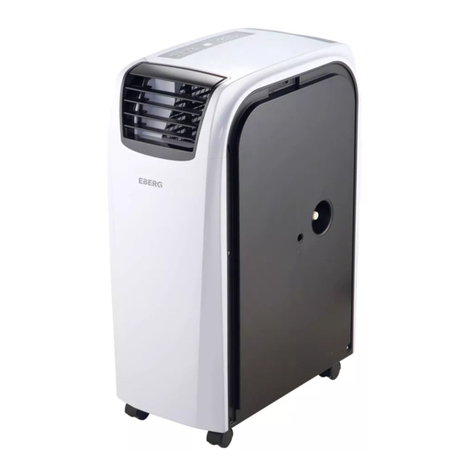
Eberg
Eberg QUBO Q40HD instruction manual

Hitachi
Hitachi RA-13JF1 Operation and installation manual

